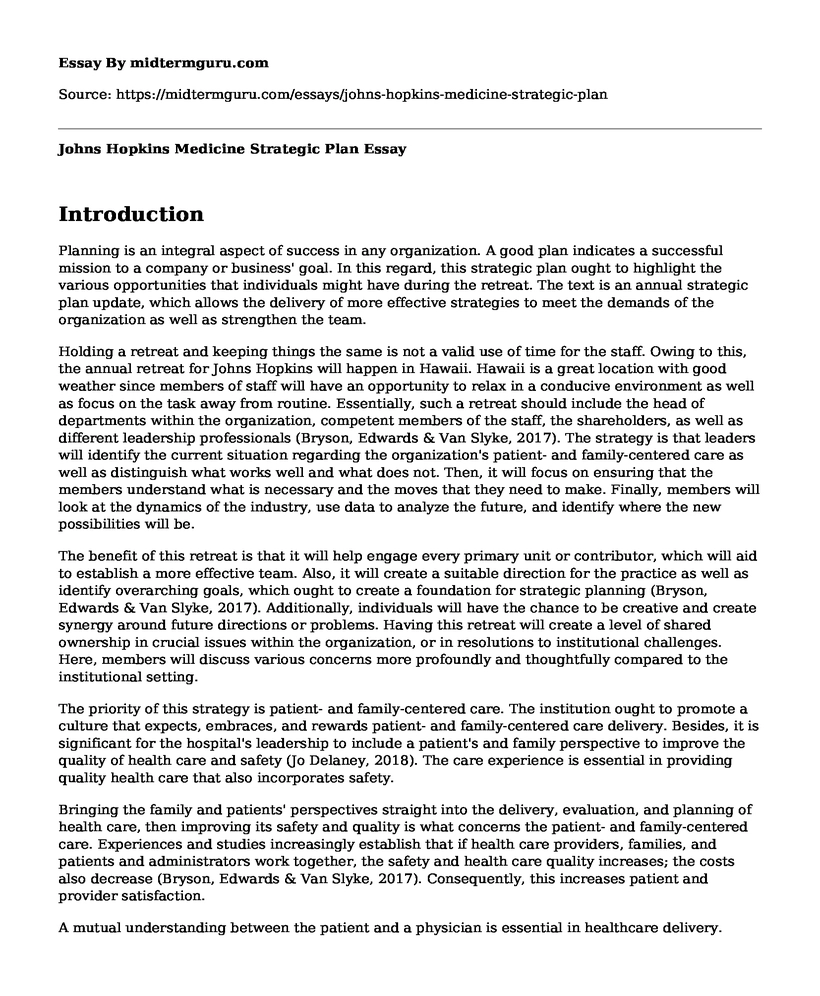Introduction
Planning is an integral aspect of success in any organization. A good plan indicates a successful mission to a company or business' goal. In this regard, this strategic plan ought to highlight the various opportunities that individuals might have during the retreat. The text is an annual strategic plan update, which allows the delivery of more effective strategies to meet the demands of the organization as well as strengthen the team.
Holding a retreat and keeping things the same is not a valid use of time for the staff. Owing to this, the annual retreat for Johns Hopkins will happen in Hawaii. Hawaii is a great location with good weather since members of staff will have an opportunity to relax in a conducive environment as well as focus on the task away from routine. Essentially, such a retreat should include the head of departments within the organization, competent members of the staff, the shareholders, as well as different leadership professionals (Bryson, Edwards & Van Slyke, 2017). The strategy is that leaders will identify the current situation regarding the organization's patient- and family-centered care as well as distinguish what works well and what does not. Then, it will focus on ensuring that the members understand what is necessary and the moves that they need to make. Finally, members will look at the dynamics of the industry, use data to analyze the future, and identify where the new possibilities will be.
The benefit of this retreat is that it will help engage every primary unit or contributor, which will aid to establish a more effective team. Also, it will create a suitable direction for the practice as well as identify overarching goals, which ought to create a foundation for strategic planning (Bryson, Edwards & Van Slyke, 2017). Additionally, individuals will have the chance to be creative and create synergy around future directions or problems. Having this retreat will create a level of shared ownership in crucial issues within the organization, or in resolutions to institutional challenges. Here, members will discuss various concerns more profoundly and thoughtfully compared to the institutional setting.
The priority of this strategy is patient- and family-centered care. The institution ought to promote a culture that expects, embraces, and rewards patient- and family-centered care delivery. Besides, it is significant for the hospital's leadership to include a patient's and family perspective to improve the quality of health care and safety (Jo Delaney, 2018). The care experience is essential in providing quality health care that also incorporates safety.
Bringing the family and patients' perspectives straight into the delivery, evaluation, and planning of health care, then improving its safety and quality is what concerns the patient- and family-centered care. Experiences and studies increasingly establish that if health care providers, families, and patients and administrators work together, the safety and health care quality increases; the costs also decrease (Bryson, Edwards & Van Slyke, 2017). Consequently, this increases patient and provider satisfaction.
A mutual understanding between the patient and a physician is essential in healthcare delivery. According to Millenson et al. (2016), the AMA Code of Medical Ethics has various formal opinion sections concerning the relationship between a physician and the patient, which demands a "mutually respectful alliance" between the two. The alliance is a significant part of the patient- and family-centered.
Conclusion
Members of staff should act in an ethical manner that enhances clinical results, which is an integral requirement of the patient- and family-centered care. In this regard, the members are required to consult with the family and patient concerning treatment.
References
Bryson, J., Edwards, L., & Van Slyke, D. (2017). Getting strategic about strategic planning research. Public Management Review, 20(3), 317-339. doi: 10.1080/14719037.2017.1285111
Jo Delaney, L. (2018). Patient-centered care as an approach to improving health care in Australia. Collegian, 25(1), 119-123. doi: 10.1016/j.colegn.2017.02.005
Millenson, M., Shapiro, E., Greenhouse, P., & III, A. (2018). "Patient- and Family-Centered Care: A Systematic Approach to Better Ethics and Care." Retrieved from https://journalofethics.ama-assn.org/article/patient-and-family-centered-care-systematic-approach-better-ethics-and-care/2016-01
Cite this page
Johns Hopkins Medicine Strategic Plan. (2022, Oct 04). Retrieved from https://midtermguru.com/essays/johns-hopkins-medicine-strategic-plan
If you are the original author of this essay and no longer wish to have it published on the midtermguru.com website, please click below to request its removal:
- Product Comparison in Terms of Packaging Bottles Designs of Shaving Creams
- Safety Issue and the Challenges of the Turkish Tourism Industry as a Result of Terror - Paper Sample
- Changing Bad Habits: Single-Subject Design
- Strategies for Global Firms' Organizational Structure: Paper Example
- The Business Strategies of the United Fruit Company - Paper Example
- Gender & Leadership: Impact on Organizational Performance - Essay Sample
- The Success of an Organization: Balancing Stakeholder & Management Roles - Essay Sample







